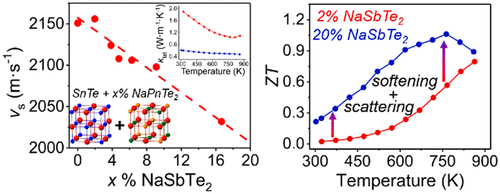当前位置:
X-MOL 学术
›
J. Am. Chem. Soc.
›
论文详情
Our official English website, www.x-mol.net, welcomes your
feedback! (Note: you will need to create a separate account there.)
Contrasting SnTe–NaSbTe2 and SnTe–NaBiTe2 Thermoelectric Alloys: High Performance Facilitated by Increased Cation Vacancies and Lattice Softening
Journal of the American Chemical Society ( IF 14.4 ) Pub Date : 2020-07-06 , DOI: 10.1021/jacs.0c05650 Tyler J Slade 1 , Koushik Pal 2 , Jann A Grovogui 2 , Trevor P Bailey 3 , James Male 2 , Jason F Khoury 1 , Xiuquan Zhou 4 , Duck Young Chung 4 , G Jeffrey Snyder 2 , Ctirad Uher 3 , Vinayak P Dravid 2 , Chris Wolverton 2 , Mercouri G Kanatzidis 1, 4
Journal of the American Chemical Society ( IF 14.4 ) Pub Date : 2020-07-06 , DOI: 10.1021/jacs.0c05650 Tyler J Slade 1 , Koushik Pal 2 , Jann A Grovogui 2 , Trevor P Bailey 3 , James Male 2 , Jason F Khoury 1 , Xiuquan Zhou 4 , Duck Young Chung 4 , G Jeffrey Snyder 2 , Ctirad Uher 3 , Vinayak P Dravid 2 , Chris Wolverton 2 , Mercouri G Kanatzidis 1, 4
Affiliation

|
Defect chemistry is critical to designing high performance thermoelectric materials. In SnTe, the naturally large density of cation vacancies results in excessive hole doping and frustrates the ability to control the thermoelectric properties. Yet, recent work also associates the vacancies with suppressed sound velocities and low lattice thermal conductivity, underscoring the need to understand the interplay between alloying, vacancies, and the transport properties of SnTe. Here, we report solid solutions of SnTe with NaSbTe2 and NaBiTe2 (NaSnmSbTem+2 and NaSnmBiTem+2, respectively) and focus on the impact of the ternary alloys on the cation vacancies and thermoelectric properties. We find introduction of NaSbTe2, but not NaBiTe2, into SnTe nearly doubles the natural concentration of Sn vacancies. Furthermore, DFT calculations suggest that both NaSbTe2 and NaBiTe2 facilitate valence band convergence and simultaneously narrow the band gap. These effects improve the power factors but also make the alloys more prone to detrimental bipolar diffusion. Indeed, the performance of NaSnmBiTem+2 is limited by strong bipolar transport and only exhibits modest maximum ZTs ≈ 0.85 at 900 K. In NaSnmSbTem+2 however, the doubled vacancy concentration raises the charge carrier density and suppresses bipolar diffusion, resulting in superior power factors than those of the Bi-containing analogues. Lastly, NaSbTe2 incorporation lowers the sound velocity of SnTe to give glasslike lattice thermal conductivities. Facilitated by the favorable impacts of band convergence, vacancy-augmented hole concentration, and lattice softening, NaSnmSbTem+2 reaches high ZT ≈ 1.2 at 800-900 K and a competitive average ZTavg of 0.7 over 300-873 K. The difference in ZT between two chemically similar compounds underscores the importance of intrinsic defects in engineering high-performance thermoelectrics.
中文翻译:

对比 SnTe-NaSbTe2 和 SnTe-NaBiTe2 热电合金:通过增加的阳离子空位和晶格软化促进高性能
缺陷化学对于设计高性能热电材料至关重要。在 SnTe 中,自然大密度的阳离子空位导致过多的空穴掺杂并阻碍控制热电性能的能力。然而,最近的工作还将空位与抑制的声速和低晶格热导率联系起来,强调需要了解合金化、空位和 SnTe 的传输特性之间的相互作用。在这里,我们报告了 SnTe 与 NaSbTe2 和 NaBiTe2(分别为 NaSnmSbTem+2 和 NaSnmBiTem+2)的固溶体,并重点关注三元合金对阳离子空位和热电性能的影响。我们发现将 NaSbTe2 而不是 NaBiTe2 引入到 SnTe 中几乎使 Sn 空位的自然浓度加倍。此外,DFT 计算表明 NaSbTe2 和 NaBiTe2 促进价带收敛并同时缩小带隙。这些效应提高了功率因数,但也使合金更容易发生有害的双极扩散。实际上,NaSnmBiTem+2 的性能受到强双极输运的限制,并且在 900 K 时仅表现出适度的最大 ZT ≈ 0.85。然而,在 NaSnmSbTem+2 中,加倍的空位浓度提高了电荷载流子密度并抑制了双极扩散,从而产生了卓越的功率比含 Bi 类似物的因素。最后,NaSbTe2 的掺入降低了 SnTe 的声速,以提供玻璃状晶格热导率。受能带收敛、空位增强空穴浓度和晶格软化的有利影响,NaSnmSbTem+2 达到高 ZT ≈ 1。
更新日期:2020-07-06
中文翻译:

对比 SnTe-NaSbTe2 和 SnTe-NaBiTe2 热电合金:通过增加的阳离子空位和晶格软化促进高性能
缺陷化学对于设计高性能热电材料至关重要。在 SnTe 中,自然大密度的阳离子空位导致过多的空穴掺杂并阻碍控制热电性能的能力。然而,最近的工作还将空位与抑制的声速和低晶格热导率联系起来,强调需要了解合金化、空位和 SnTe 的传输特性之间的相互作用。在这里,我们报告了 SnTe 与 NaSbTe2 和 NaBiTe2(分别为 NaSnmSbTem+2 和 NaSnmBiTem+2)的固溶体,并重点关注三元合金对阳离子空位和热电性能的影响。我们发现将 NaSbTe2 而不是 NaBiTe2 引入到 SnTe 中几乎使 Sn 空位的自然浓度加倍。此外,DFT 计算表明 NaSbTe2 和 NaBiTe2 促进价带收敛并同时缩小带隙。这些效应提高了功率因数,但也使合金更容易发生有害的双极扩散。实际上,NaSnmBiTem+2 的性能受到强双极输运的限制,并且在 900 K 时仅表现出适度的最大 ZT ≈ 0.85。然而,在 NaSnmSbTem+2 中,加倍的空位浓度提高了电荷载流子密度并抑制了双极扩散,从而产生了卓越的功率比含 Bi 类似物的因素。最后,NaSbTe2 的掺入降低了 SnTe 的声速,以提供玻璃状晶格热导率。受能带收敛、空位增强空穴浓度和晶格软化的有利影响,NaSnmSbTem+2 达到高 ZT ≈ 1。











































 京公网安备 11010802027423号
京公网安备 11010802027423号